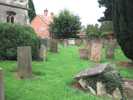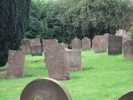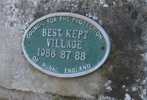Bothamsall Our Lady and St PeterChurchyard
Views of the Churchyard |
 |
 |
Bothamsall church stands, not only on rising ground but also within a churchyard
some two metres above street level; all contributing to its attractiveness
and dominant position in the village.
Its churchyard is roughly semi-circular with houses to the east. The church
occupies an area towards the north with only a narrow strip of land left there
with the majority of the area to the south. It is surrounded by a sandstone
wall in varying condition. Some stones in the south west lower level are extremely
worn. Near the houses, to the south east, the wall is of brick.
There are two entrances. The narrower one is conveniently in the north east
corner as the vicarage lies about 300 metres further east. Several stone steps
lead to a grassed area. One path leads around the church while the shorter
one leads directly to the vestry door. At the western approach is a double-gated
entrance with several stone steps up to the path which leads to the south door.
On one side of the entrance is a cherry tree and on the other an almond has
been planted
 Plaque
by the Plaque
by the
churchyard gate |
At the same end a sign mounted on a wooden post and with a wrought iron frame
commemorates the village being winner of the annual trophy for best kept village
in Nottinghamshire with a population of under 300, while a small metal plaque
affixed to the outside wall states that it was won in the years 1986, 1987
and 1988. A second sign gives details of church name, time of services etc.
In the south east corner of the churchyard is a designated wild area. The
churchyard is not “over-maintained” and only a handful of broken
grave markers stand against the east wall. Several trees including yew, Scotch
pine and two oak trees along with other evergreens and bushes make this a very
pleasant area.
An interesting fragment of stone, about 40cms high and of conical shape stands
on the grass, close to the south wall. It is carved and may well be part of
a tower pinnacle but no information is available.
The earliest discernible grave marker is dated 1747 and commemorates a 4-year
old boy. A trio of graves very close together – indeed touching – record
the death of a father and his daughter in February 1766 and of the mother a
few months later.
The village has a second burial plot some 200 metres to the north of the church
which has been in use at least since 1945.
Family areas in the churchyard show such names as Padley, who presented a
silver chalice to the church, Mansells, who served the Dukes of Newcastle over
several generations and the William Pecks who, father and son, acted as churchwardens
over many years in the nineteenth century.
|